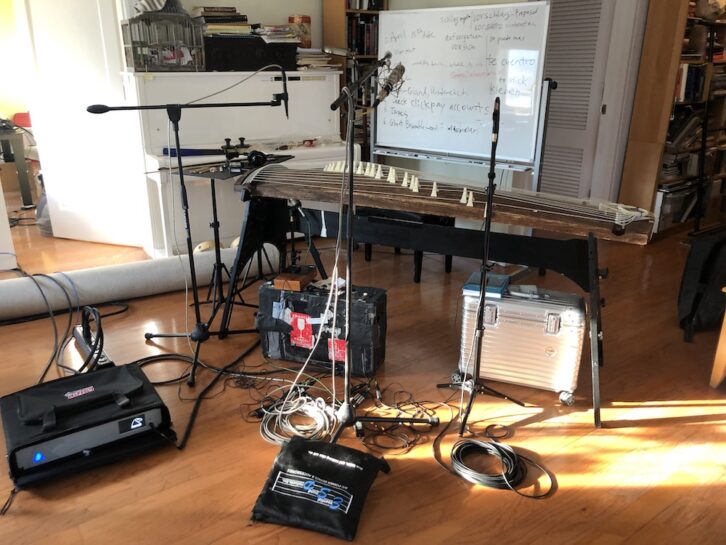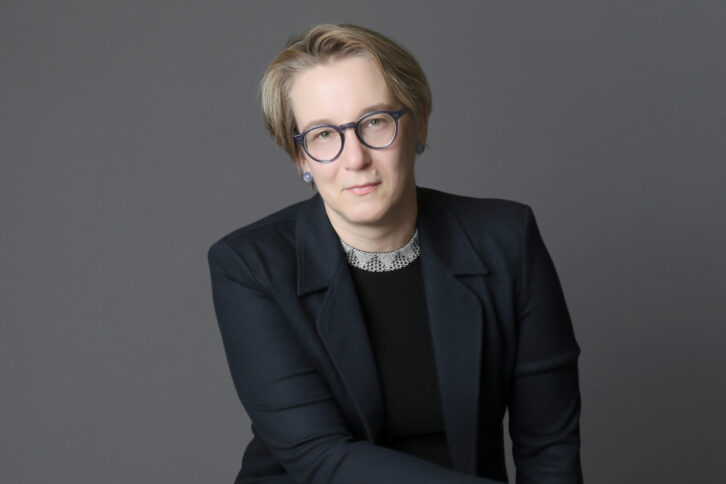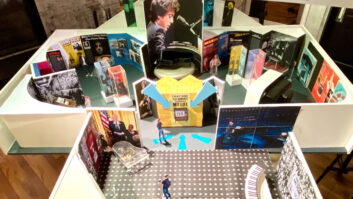
Grammy-winning soprano saxophonist and composer Jane Ira Bloom has always pushed the envelope. Her innovative spirit manifests in her music, through collaborations with iconic jazz artists like Kenny Wheeler and Charlie Haden, and world artists including South Indian veena artist Geetha Ramanathan Bennett and Korean komungo player Jin Hi Kim.
That innovative approach extends to technology, as she has proven herself to be a pioneer in the use of live electronics in jazz and a passionate advocate of high-resolution and immersive recording. In a most interesting side note, she was the first musician commissioned by the NASA Art Program, and even has an asteroid named after her: asteroid 6083janeirabloom.
So when Bloom set out to record her 19th album, Picturing the Invisible: Focus 1, in 2020— right at the onset of the Covid pandemic—she made a radical move that pushed her to her creative limits, while bringing a new sense of immediacy and honesty to the collaborative process.
Picturing the Invisible: Focus 1 is a series of eight compositions inspired by the striking, spare, black-and-white science photography of New York City artist Berenice Abbott. “I looked at these unbelievably gorgeous, scientific photos that Berenice Abbott took in the ’50s and ’60s,” Bloom recalls. “They were demonstrations of what goes on in physics with light waves and sound waves, and had never been done before. They’re just starkly beautiful.”
The expression of cyclical motion and momentum and ebb and flow in the photographs resonated with her as an improviser, she says: “I was interested in how sound changes when it moves, and physics.”
For the project, supported by the New York City Women’s Fund for Media, Music and Theatre, Bloom wanted to bring art and audio science together in a way that mirrored the original impulse of Abbott’s photography. “The idea of a very powerful visionary artist, a female artist like Berenice Abbott, communicated to me,” she says, “and then the idea that this could be a sound capture where art and science could mingle in a way that would be very new and exciting.”
“These pictures kind of look like the pictures that you get in audiobooks, like the interferences when you have two sound sources that overlay each other,” adds recording engineer Ulrike Schwarz. “In order to make these interferences really audible, I thought, ‘That calls for super-high resolution, and wouldn’t it be even cooler if it was also 3D?’”
Picturing the Invisible: Focus 1—which was nominated for a Grammy in Best Immersive Album after this story was turned in—is now an ultra-high-resolution recording available in stereo and 5.1 surround (up to 384 kHz/32-bit), Dolby Atmos, AURO-3D FLAC (96 kHz/24-bit), and high-resolution streaming in MQA and other formats.

IMMERSIVE IN MIND
Bloom has long embraced immersive recording, a passion borne out of her decades-long collaborative partnership with producer/ engineer team (and married partners) Ulrike Schwarz and Jim Anderson.
“My music has always had a strong interest in how sound changes when it moves,” Bloom explains. “The history of working with Jim and my music has also been thinking very fully about how to amplify it into an immersive audio recording experience.”
An idea evolved to employ high-resolution, immersive recording techniques to capture music that Bloom would compose and perform with several world-renowned improvisers in New York. The pieces were written, studio plans were beginning to take shape…and then, the world shut down.
Reimagining the Jane Ira Bloom project in the face of pandemic limitations meant forming a new means of recording. The focus shifted to honing the music into duets and devising a way for musicians to improvise together in real-time, connecting remotely from their homes in New York City, while preserving the highest level of immersive sound capability.
“The way we imagined this was, spare was better, both compositionally and sonically,” says Bloom. She paired with three renowned improvisers: drummer Allison Miller, koto artist Miya Masaoka and bassist Mark Helias. “I couldn’t do this with just anybody,” she adds. “These are musicians whom I have a history of playing with, so there’s a lot of collaborative vocabulary that we already shared for many, many years of performing.”
“It became, ‘Let’s really focus on silence,’” says Schwarz, “but still, I was hoping to keep the 3D element. I knew we would go to very, very small rooms and not ideal rooms, but in the end, we were still able to get there because later we took it out to our favorite live chamber at Skywalker Sound, where it was mixed by Jim.”

HI-RES TRACKING AT HOME
Tracking took place over three days in February 2022. The project was recorded, mixed and mastered using Merging Technologies Horus/Pyramix recording systems and the Merging+Clock U. Schwarz set up a computer in Bloom’s tiny home office, applying ad-hoc acoustic treatment: towels on a desk, a coat on the sofa. The workstation in Bloom’s office, remotely controlled by Schwarz, ran at 384 kHz.
A second recording system and iPad (equipped with a high-speed internet hub for gaming to accelerate the process) traveled with Schwarz to each of the other musician’s homes. The musicians used Zoom as a visual reference and communicated sonically through SonoBus.
The recording chain was minimalist, centered mainly around a stereo mic pair: one Sanken CU-41 and one Neumann TLM170.
“Instead of the usual seven microphones or sometimes nine that Jim [Anderson] would be using in a studio recording, we had to bring it down to stereo, so that was the part that I really had to figure out,” says Schwarz, “and then, of course, you have to hope that these people live in somewhat quiet apartment buildings.
“What is special about this album is that we used a normal internet connection that was available from each musician’s home,” she adds, noting that she was able to keep latency to a level that made improvising possible. “I mean, if I had asked someone in broadcast, ‘Hey, I need two of these units and I need a fixed bandwidth for half an hour,’ that wouldn’t have been that spectacular. But the way we did it— recording on both ends in super-high definition and doing it with ‘home means’ using personal computers— that made it unique.

“I had spent a lot of time calculating bandwidth and calculating speeds to find out what I could get away with, because all these latencies relate to sample rate,” she continues. “If you go with 192 kHz, you have a fourth of the time than if you were at 48, and a lot less than if you tried to do this with any type of data-reduced signal.”
Schwarz quickly hit a snag at Miya Masaoka’s house. “I was checking the internet, and I thought, ‘She has a gigabyte line; somebody’s taking speed away.’ Her son was playing video games—and when you have to tell a teenager that he has to get off the internet and not play with his friends, that’s not how you make friends. That was one thing I had to navigate.”
In the end, when connections were fast and stable, latency ran just 8 to 10 milliseconds.
“I was trying to give them something resembling a studio experience in terms of reliability,” she said, “but for me, it was really more of a guerrilla command, in that I had to keep everybody and everything a little bit under control.”

HI-RES, IMMERSIVE MASTERING
The Jane Ira Bloom recordings and rig were sent to Skywalker Sound, where Anderson created immersive mixes. “We flew the whole shebang there: The clock was there, the power was there,” says Schwarz, who, together with Anderson, frequently works at Skywalker. “It’s really nice that they let us completely take their studio and turn it into our studio.”
Schwarz mastered the stereo and 5.1 mixes at Anderson Audio, a studio she shares with her husband in their home in Brooklyn. “In my editing suite, I have Wilson CUBs and an Eclipse TD725SW subwoofer,” she explains. “When I’m working, I’m listening through the Pyramix and sometimes have our clock there as well, to really see what’s going on. The amps are Benchmark ABH2 mono blocks and HPA4 preamplifier. My favorite headphones are B&W P5s; I took them with me for these recordings.”
She mastered the immersive mixes in collaboration with Morten Lindberg, in his newly updated Oslo studio: “With the help of Morten, we are able to not only offer this breathtaking album in conventional formats like stereo and 5.1 surround, but also in immersive audio on streaming and download platforms.”
Franco Ambrosetti’s ‘Nora’—Capturing a Jazz Legacy in Hi-Res, 5.1 Surround
Ultimately, Jane Ira Bloom’s Picturing the Invisible is a stunning study in contrasts: sound and silence, simple and complex, high-tech and low-tech, together and apart. “I say this with great passion: Sometimes it’s the negative space, it’s the use of silence as well as sound in this recording that makes it unique, thinking of an immersive sound environment,” says Bloom.
“It’s a rare moment in a musical life where the sound—which your ears are so attuned to the depth, the timbre of it, the spaciousness of it—is ever really captured in the level of definition that Ulrike is capturing,” she adds. “That is such an extraordinary experience for the artist because it’s reaffirming sonically what you experience internally, but almost never experience in the normal recording world. It’s a peak musical experience; that’s the best way I can describe it.”







